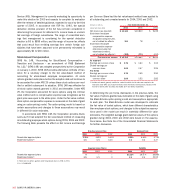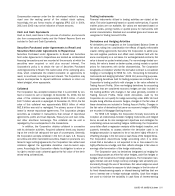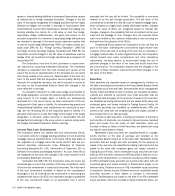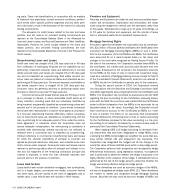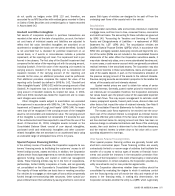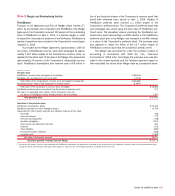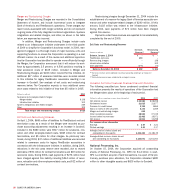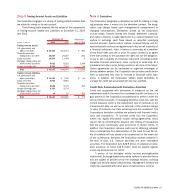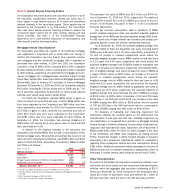Bank of America 2004 Annual Report Download - page 108
Download and view the complete annual report
Please find page 108 of the 2004 Bank of America annual report below. You can navigate through the pages in the report by either clicking on the pages listed below, or by using the keyword search tool below to find specific information within the annual report.
do not qualify as hedges under SFAS 133 and, therefore, are
accounted for as AFS Securities with realized gains recorded in Gains
on Sales of Debt Securities and unrealized gains or losses recorded
in Accumulated OCI.
Goodwill and Other Intangibles
Net assets of companies acquired in purchase transactions are
recorded at fair value at the date of acquisition, as such, the histori-
cal cost basis of individual assets and liabilities are adjusted to
reflect their fair value. Identified intangibles are amortized on an
accelerated or straight-line basis over the period benefited. Goodwill
is not amortized but is reviewed for potential impairment on an
annual basis, or if events or circumstances indicate a potential
impairment, at the reporting unit level. The impairment test is per-
formed in two phases. The first step of the Goodwill impairment test
compares the fair value of the reporting unit with its carrying amount,
including Goodwill. If the fair value of the reporting unit exceeds its
carrying amount, Goodwill of the reporting unit is considered not
impaired; however, if the carrying amount of the reporting unit
exceeds its fair value, an additional procedure must be performed.
That additional procedure compares the implied fair value of the
reporting unit’s Goodwill (as defined in SFAS No. 142, “Goodwill and
Other Intangible Assets” (SFAS 142)) with the carrying amount of that
Goodwill. An impairment loss is recorded to the extent that the car-
rying amount of Goodwill exceeds its implied fair value. In 2004,
2003 and 2002, Goodwill was tested for impairment and no impair-
ment charges were recorded.
Other intangible assets subject to amortization are evaluated
for impairment in accordance with SFAS No. 144 “Accounting for the
Impairment or Disposal of Long-Lived Assets” (SFAS 144). An impair-
ment loss will be recognized if the carrying amount of the intangible
asset is not recoverable and exceeds fair value. The carrying amount
of the intangible is considered not recoverable if it exceeds the sum
of the undiscounted cash flows expected to result from the use of the
asset. At December 31, 2004, intangible assets included on the
Consolidated Balance Sheet consist of core deposit intangibles,
purchased credit card relationship intangibles and other customer-
related intangibles that are amortized on an accelerated basis using
an estimated range of anticipated lives of 6 to 10 years.
Special Purpose Financing Entities
In the ordinary course of business, the Corporation supports its cus-
tomers’ financing needs by facilitating the customers’ access to dif-
ferent funding sources, assets and risks. In addition, the Corporation
utilizes certain financing arrangements to meet its balance sheet man-
agement, funding, liquidity, and market or credit risk management
needs. These financing entities may be in the form of corporations,
partnerships, limited liability companies or trusts, and are generally
not consolidated on the Corporation’s Consolidated Balance Sheet.
The majority of these activities are basic term or revolving securitiza-
tion vehicles for mortgages or other types of loans which are generally
funded through term-amortizing debt structures. Other special pur-
pose entities finance their activities by issuing short-term commercial
paper. Both types of vehicles are designed to be paid off from the
underlying cash flows of the assets held in the vehicle.
Securitizations
The Corporation securitizes, sells and services interests in residential
mortgage loans, and from time to time, consumer finance, commercial
and credit card loans. The accounting for these activities are governed
by SFAS 140, “Accounting for Transfers and Servicing of Financial
Assets and Extinguishments of Liabilities – a replacement of FASB
Statement No. 125” (SFAS 140). The securitization vehicles are
Qualified Special Purpose Entities (QSPEs) which, in accordance with
SFAS 140, are legally isolated, bankruptcy remote and beyond the con-
trol of the seller. QSPEs are not included in the consolidated financial
statements of the seller. When the Corporation securitizes assets, it
may retain interest-only strips, one or more subordinated tranches and,
in some cases, a cash reserve account which are generally considered
residual interests in the securitized assets. The Corporation may also
retain senior tranches in these securitizations. Gains and losses upon
sale of the assets depend, in part, on the Corporation’s allocation of
the previous carrying amount of the assets to the retained interests.
Previous carrying amounts are allocated in proportion to the relative fair
values of the assets sold and interests retained.
Quoted market prices are used to obtain fair values of senior
retained interests. Generally, quoted market prices for retained resid-
ual interests are not available; therefore, the Corporation estimates
fair values based upon the present value of the associated expected
future cash flows. This may require management to estimate credit
losses, prepayment speeds, forward yield curves, discount rates and
other factors that impact the value of retained interests. See Note 8
of the Consolidated Financial Statements for further discussion.
The excess cash flows expected to be received over the amor-
tized cost of the retained interest is recognized as Interest Income
using the effective yield method. If the fair value of the retained inter-
est has declined below its carrying amount and there has been an
adverse change in estimated contractual cash flows of the underlying
assets, then such decline is determined to be other-than-temporary
and the retained interest is written down to fair value with a corre-
sponding adjustment to earnings.
Other Special Purpose Financing Entities
Other special purpose financing entities are generally funded with
short-term commercial paper. These financing entities are usually
contractually limited to a narrow range of activities that facilitate the
transfer of or access to various types of assets or financial instru-
ments and provide the investors in the transaction protection from
creditors of the Corporation in the event of bankruptcy or receivership
of the Corporation. In certain situations, the Corporation provides liq-
uidity commitments and/or loss protection agreements.
The Corporation determines whether these entities should be
consolidated by evaluating the degree to which it maintains control
over the financing entity and will receive the risks and rewards of the
assets in the financing entity. In making this determination, the
Corporation considers whether the entity is a QSPE, which is generally
BANK OF AMERICA 2004 107







